Choosing the best warm white paint colors can feel like an overwhelming task. You’ve stared at countless swatches, agonized over undertones, and maybe even painted a few sample swatches on your walls—only to feel more uncertain than before.
I’ve been there too, and I know how frustrating it can be. But don’t worry; I’m here to help demystify the process and share tips to make picking a paint color a little easier. The best part, I have used all the paint colors I am going to talk about in today's post!
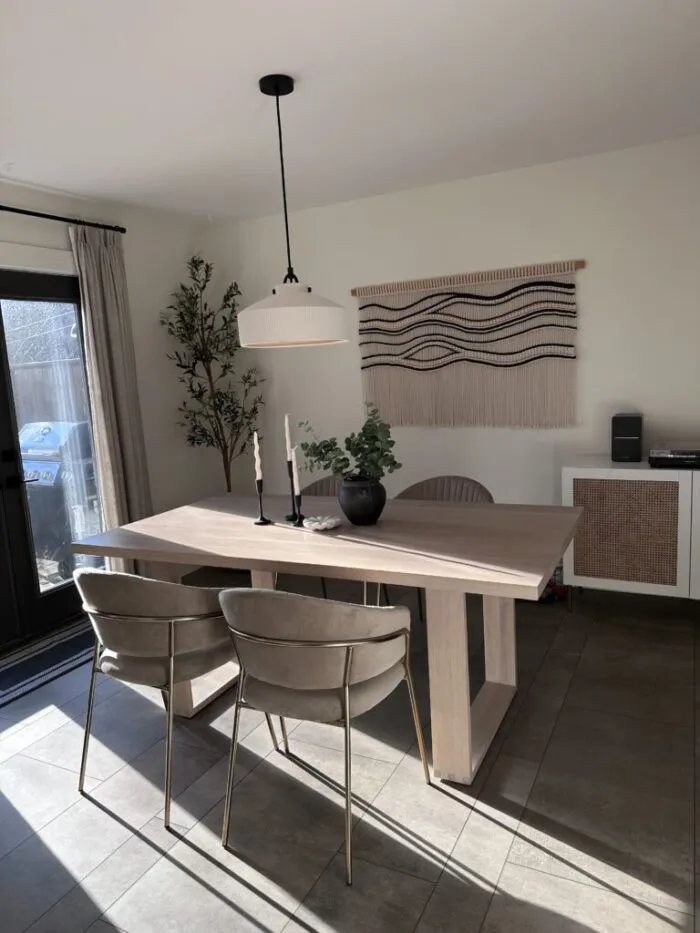
Photo above: wall color is Dover White SW, trim is Alabaster SW, patio door is Urbane Bronze SW.
One of the most important factors to consider when selecting the best warm white paint colors is how lighting affects the way it looks in your space. Natural light plays a massive role in how a color appears. The same paint color can look entirely different in a north-facing room compared to a south-facing one. Add in factors like surrounding decor, flooring, and artificial lighting, and it’s no wonder so many of us feel stuck!
The Role of Natural Light in Best Warm White Paint Colors
Rooms that face north tend to have cooler, bluer light. In these spaces, warm or creamy whites like Sherwin-Williams Dover White, Alabaster, or Greek Villa can help counteract the coolness, creating a cozy and inviting vibe.
On the flip side, south-facing rooms get warm, golden light throughout the day, which can make some warm-toned colors appear even warmer—sometimes too yellow. A balanced white like Greek Villa by Sherwin-Williams works beautifully in these rooms. You could also opt for a color with more grey undertones like Calm by Benjamin Moore.

East-facing rooms have warm light in the morning but cooler tones in the afternoon. In these spaces, the paint color can shift dramatically throughout the day. West-facing rooms, on the other hand, get cooler light in the morning and warm, golden light in the evening. For rooms where lighting shifts, testing paint samples on multiple walls is essential and be sure to check on it throughout the day as the light changes.
What is LRV and Why It Matters for Warm White Paint Colors
When choosing a paint color, it’s important to consider its Light Reflectance Value (LRV). LRV measures the amount of light a color reflects, on a scale of 0 (absorbing all light) to 100 (reflecting all light). Understanding LRV can help you choose the right color for your space based on the natural and artificial lighting available.
The direction your room faces plays a big role in determining the ideal LRV range for your warm white paint:
- North-facing rooms tend to receive cooler, bluish light, which can make whites appear starker or even slightly gray. To counteract this, choose a warm white with a mid-to-high LRV (around 75-85) to help reflect light while adding warmth—colors like Alabaster or Dover White work well here.
- South-facing rooms get bright, warm light throughout the day, which can make whites appear even warmer. In these spaces, a white with an LRV of 80-88 is ideal to maintain balance without becoming too yellow—think Greek Villa or Calm.
- East-facing rooms have soft, warm light in the morning but cooler tones in the afternoon, so an LRV in the 78-85range ensures a cozy feel throughout the day.
- West-facing rooms get cooler morning light and strong golden light in the afternoon, which can amplify warm tones. A balanced warm white with an LRV of 75-82 works well, preventing it from looking too stark in the morning or overly golden in the evening.
Checking the LRV of a paint color can help you predict how it will interact with your room’s lighting and ensure it achieves the effect you’re aiming for.
My Favorite Warm White Paint Colors and Why I Love Them
Let’s talk about my go-to best warm paint colors, their undertones, and why they work so well in more detail.
Dover White (SW 6385)

This is a warm white with soft, creamy undertones. It’s perfect for creating a cozy and inviting feel, especially in spaces with cool lighting. It pairs beautifully with wood tones and adds a subtle warmth to any room.
With an LRV of 83, Dover White reflects a significant amount of light, making it a great choice for smaller spaces or rooms that need brightening.
I have this color as my primary paint color throughout my main living area. It pairs really nicely with an accent wall I have painted French Gray by Farrow and Ball. It also pairs very well with another accent wall I have painted Urbane Bronze by Sherwin Williams.
When I get a lot of bright natural light it is a beautiful bright white. In the evenings under artificial light it appears more warm.
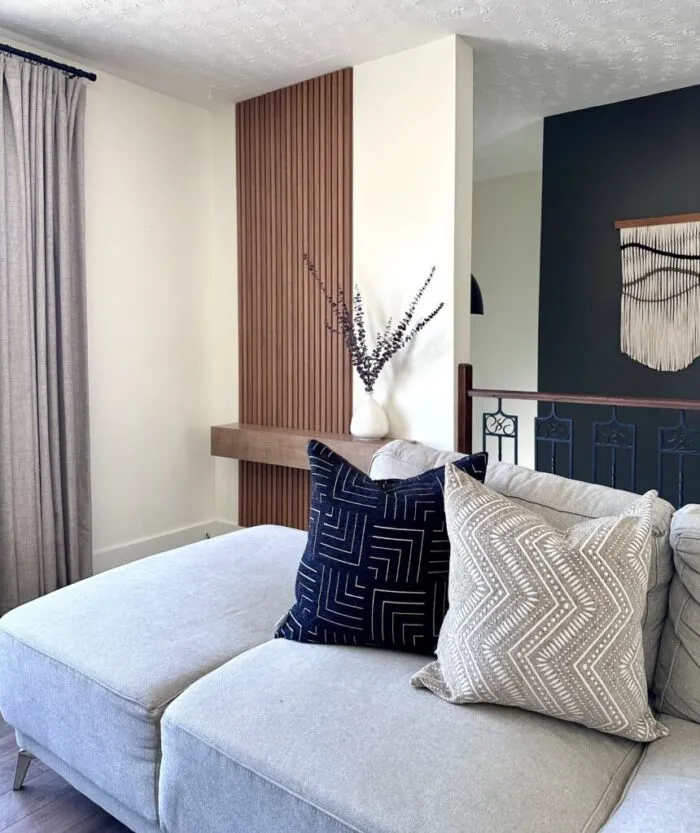
Photo above: walls Dover White SW and accent wall Urbane Bronze SW.
Alabaster (SW 7008)
Alabaster has subtle beige undertones that lean warm but remain soft and balanced. It’s less "yellow" than Dover White, making it versatile for a range of lighting conditions.
Alabaster has an LRV of 82, meaning it reflects light well while maintaining a cozy ambiance.
I have this color painted on all of my trim in the main living area in a satin finish. It pairs really nicely with Dover White. I like that it is a subtle white without being a stark white like most painted trim!
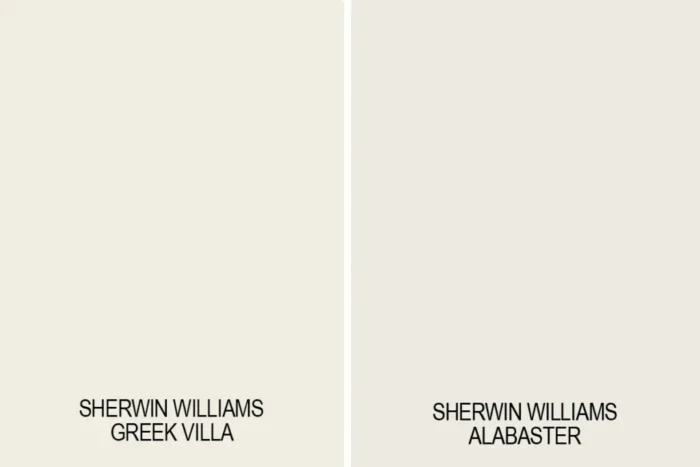
Greek Villa (SW 7551)
Greek Villa leans slightly greige, with a hint of warmth that feels soft and understated. It avoids the yellow tones of some warm whites.
With an LRV of 84, Greek Villa is one of the brighter whites, ideal for creating a light and airy feel in any room.
I really like this color as it’s a balanced white that doesn’t lean too warm or cool, making it a safe and elegant choice. I chose this color to use in my north facing bedroom and it made a massive difference with the lighting in the room. See below!
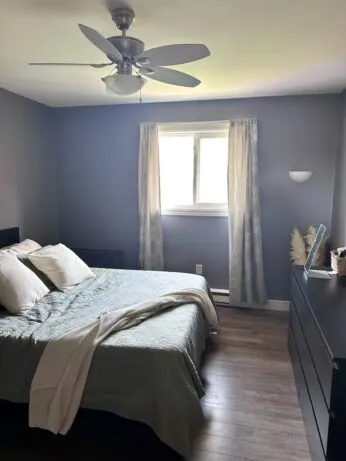
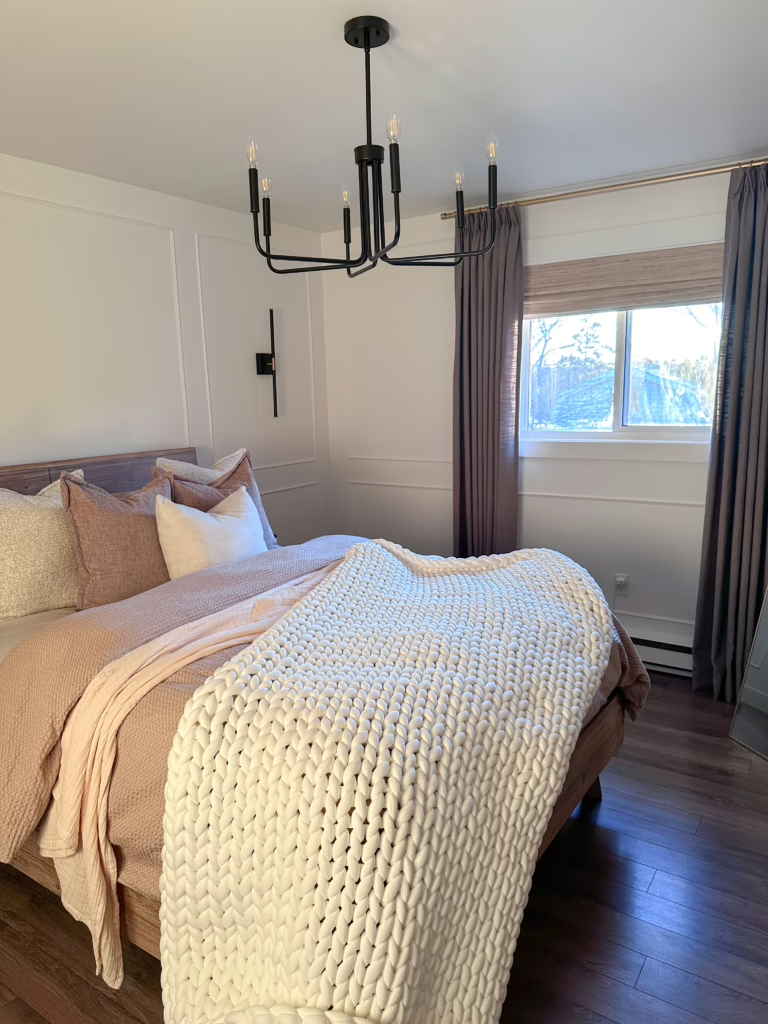
Greek Villa by Sherwin Williams is painted on the walls, trim, and ceiling in the picture on the right
Picking the Right Sheen for the best Warm White Paint Colors
Once you’ve chosen a paint color, the next decision is selecting the right sheen. The sheen you choose can impact not only the appearance of the paint but also its durability and how easy it is to clean.
I personally prefer a satin finish for most surfaces. Satin offers a soft, subtle sheen that’s not too shiny but still reflects enough light to give your walls a polished look. It’s also incredibly practical: it’s easy to clean and holds up well in high-traffic areas like kitchens, hallways, and bathrooms.
Here’s a quick rundown of common sheens and where they work best:
- Flat/Matte: Great for ceilings and low-traffic areas. It hides imperfections well but is harder to clean.
- Eggshell: Slightly more durable than flat with a touch of sheen. Good for living rooms and bedrooms.
- Satin: My go-to finish! It’s versatile, durable, and works well in almost any space.
- Semi-Gloss: Perfect for trim, doors, and cabinetry. It’s shiny and easy to clean.
- High-Gloss: The most reflective and durable option. Great for accent pieces or surfaces that need to withstand heavy wear.
Choosing the right sheen can elevate your paint color and make your space look professionally finished while ensuring the paint holds up to your lifestyle.
You can check out Sherwin Williams paint colors here.
Tips for picking the best warm white paint colors
- Sample, Sample, Sample: Paint swatches are a good start, but nothing beats trying samples directly on your walls. Paint large sections and observe them at different times of the day to see how the light affects the color.
- Consider Undertones: Every paint color has undertones, whether they’re warm (yellow, red, orange) or cool (blue, green, purple). Make sure the undertones of your paint complement your existing décor.
- Start with Neutrals: If you’re feeling overwhelmed, begin with a versatile neutral. Whites, greiges, and soft beiges are timeless and work well in any space.
- Trust Your Instincts: At the end of the day, you’re the one who will live with the color. Choose something that makes you feel happy and comfortable in your space.
Picking the perfect and best warm white paint colors doesn’t have to be daunting. By considering your room’s lighting, understanding undertones, and testing colors before committing, you can create a space that feels just right. Hopefully, these tips and my favorite warm white paint picks inspire you to tackle your next painting project with confidence!
Loved this DIY? Let’s keep the creativity flowing!
Save this project for later by pinning it to your favorite Pinterest board! 📌 One click, and you’ll always know where to find it when you’re ready to dive in.

Craving more DIY ideas?
Join my insider circle by signing up for my newsletter! You’ll get:
Exclusive step-by-step guides you won’t find anywhere else.
Budget-friendly home tips that make a big impact.
My personal go-to product recommendations.
Early access to brand-new DIY projects before they go live!
You might like my blog post on how I transformed my bedroom from dull and dark to bright and airy in a north facing room!


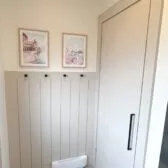

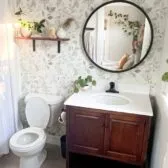


This was very helpful!!! I was set on using Dover white but the more I look at swatches, I think I’ll need SW snowbound. I’m wanting to avoid a “cream look.”
What would you suggest for a living room with no windows?
I’m needing to paint my bedroom with a window facing south and a living room with no windows at all. I’m wanting a rimless, classy white that doesn’t look yellow or gray!
So happy it was helpful! I think Dover White is going to be more cream than you want as I have it in my main living area and it sometimes has that very warm creamy look depending on the light. I haven't used snowbound but it looks like it will pull more grey. Greek Villa is a great shade, when it is dark and just the lights on it still looks "white". I highly recommend paint swatches and to look at them throughout the day to ensure you like it in all lightings!